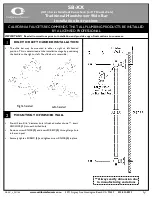
petsafe.com 11
Pregnant women, babies, small children and immune deficient individuals should avoid contact with cat litter waste. Cats’
waste may contain toxoplasmosis bacteria that can be harmful to these individuals.
• If solid waste is collecting outside the waste trap, it is time to change the litter tray.
• Increased elimination habits of cats who consume a high diet high in crude fiber, ash and byproducts, cats older than 10 years of
age and cats with diabetes, kidney and thyroid problems may result in shorter tray life. Kittens may have softer stool than mature
cats, which increases the likelihood that it may stick to the rake.
• Using the tray longer than recommended may result in leakage. Placing the litter box in a high humidity area, such as a bathroom or
near a shower, may result in shorter tray life.
Maximizing Litter Tray Life
Here are some tips to help get the most life from the ScoopFree
®
Disposable Crystal Litter Tray:
• The crystal litter trays work best if placed AWAY from areas of high humidity such as bathrooms, showers and basements. Moisture
in the air can shorten the life of the crystal litter and disposable tray. Place the ScoopFree litter box in a room with moving air to pull
away moisture, such as a room with a fan.
• Cats with diets high in crude fiber and ash content will produce more solid waste, which may prematurely fill the waste trap. Consider
changing your cat’s diet to a food with no byproducts or fillers.
• Increased elimination habits of older cats and cats with diabetes, kidney and thyroid problems may result in a shorter tray life.
• Stirring the crystals once a week may help the tray life for cats that are ill or have a high urine output. Stirring will also distribute
saturated crystals, which will also help with cats who consistently urinate in the same spot or do not dig. Be sure to mix in the crystal
litter from behind the rake and along the sides of the litter box, but do not mix in litter from under the waste trap.
• Kittens are not as developed, so their solid waste can be runny. Kittens will go through litter trays faster than adult cats, so it is
recommended to use ScoopFree with cats that are older than 6 months.
If your kitten is under 6 months of age, leave the unit UNPLUGGED and scoop waste until the kitten is 6 months old.
Care and Cleaning
The ScoopFree Self-Cleaning Litter Box seldom needs to be cleaned because of its revolutionary design. Surfaces that would normally
become soiled are discarded with each disposable litter tray. However, you may occasionally choose to clean the litter box.
1. Unplug the power adapter from the wall outlet, and disconnect it from the litter box.
2. Lift and remove the litter box frame from the crystal litter tray.
3. Remove the waste trap cover by tilting it outwards until the side posts fall out of the
slots on the front of the litter box frame.
4. Wipe all surfaces on the litter box frame with a cloth or sponge using mild soap and
water. Wipe the rake with a sponge or soft brush. DO NOT use bleach or chemicals to
clean as they can act as a repellent to your cat.
5. Clean the detection sensors on the interior sides of the litter box frame to make sure
they are not blocked.
6. Thoroughly dry all parts before reassembling the litter box.
7. Replace the waste trap cover, and install a new litter tray (see “Litter Box Setup” on
page 6).
Do not submerge or expose the electrical components to water or cleaning solutions.
Always unplug the unit when not in use, before putting on or taking off parts and before cleaning.
5


































